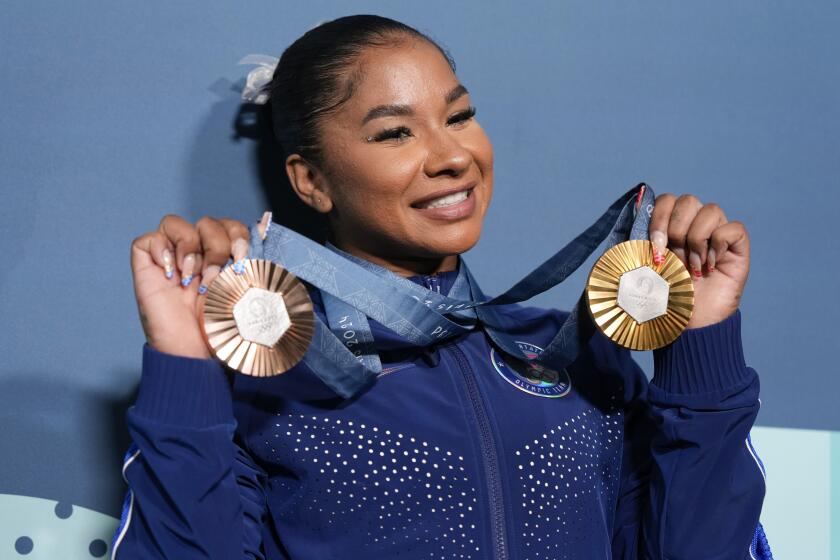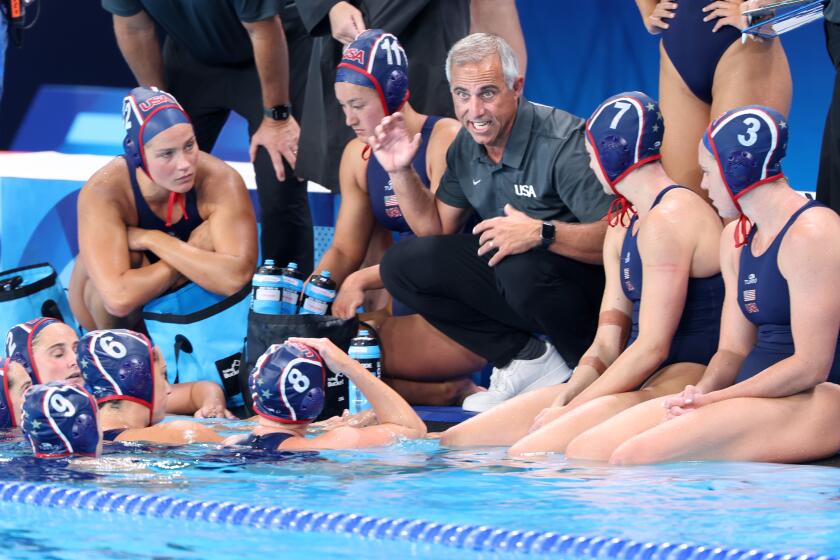Running Into History, Controversy
Instead of a test pattern on their television screens at 4 a.m., Australians trained their bleary eyes Monday on the red, black and yellow geometric designs of the aboriginal flag, as seen live from Greece in mid-victory celebration.
Australians were up and tuned in before dawn because halfway around the globe, Cathy Freeman was bidding to become the women’s world champion runner at 400 meters.
Freeman, 24, runs for one country but two cultures, represented by the Australian flag on the front of her track suit and the miniature aboriginal emblem she wears on her shoes. Her dual allegiances became a national issue in 1994, when Freeman ran a victory lap with both flags at the Commonwealth Games--a gesture interpreted by some in Australia as a protest.
Monday, after winning the gold medal at the World Championships in 49.77 seconds, Freeman replayed that moment--Australian and aboriginal flags clasped together in the same two weary hands--and let the repercussions fall where they may.
She had just become the first aborigine to win an individual gold medal in a major international track competition, and wasn’t about to push aside opportunity when it presented itself to her.
Freeman already had the Australian flag over her shoulder when a jubilant spectator leaned over the railing and offered her an aboriginal flag.
“It was quite a surprise to see that beautiful, beautiful flag,” Freeman said. “How could I afford not to take it? I’m a proud, proud indigenous Australian.”
It is a striking emblem, but also a contentious one. For the benefit of the international media, Freeman explained the color scheme: “Black for the people, red for the land, yellow for the sun.”
Those colors have often overshadowed whatever gold, silver or bronze Freeman has added to the picture during her track career.
Two years after the Commonwealth Games controversy, Freeman was forbidden from carrying the flag in Atlanta last summer after winning an Olympic silver medal in the 400.
She wears a tiny version of the flag on her shoes because her heritage “is very important for her,” according to Jamaican sprinter Sandie Richards, who occasionally trains with Freeman and finished second behind her Monday at 49.79 seconds.
It is important, Richards said, “because in Australia, [some people] don’t look at the aboriginal race as equal. There is still prejudice against Cathy Freeman, but she tries to rise above it.
“A week ago, I saw [in an Australian newspaper] some letters. I didn’t show it to her because I didn’t want to upset her before the World Championships. But she has been nominated to carry the flag at the 2000 [Olympic] Games and people wrote in to protest.
“They say she shaved her hair off just to get attention and doesn’t win all her races, so why is she so famous?
“It’s hurtful. You try to do something for your country and people don’t appreciate it.”
Freeman downplayed questions about personal experience with prejudice, claiming she had never had a “really horrible experience in terms of racial discrimination. It was never a serious problem for me.
“But when I think of the history and the way my ancestors were treated, I draw strength from that when I run.”
After winning her silver medal in Atlanta, Freeman took two months away from training to visit schools in Australia, meeting many aborigine children.
“I want the little children to feel that they have a chance,” Freeman said. “If a child can see me and touch me and learn from my experiences, it’s very powerful. . . .
“There’s a tremendous spirit in the aboriginal community. When I win, it brings a feeling of dignity again, and self-respect.”
Freeman’s exploits often transcend cultural boundaries in Australia. Rob de Castella, the 1983 world-champion marathon runner who served as commentator for Monday’s television broadcast that was shown live in Australia, said, “There are little kids all over the country running in the streets who want to be Cathy Freeman. And after this, all the mums and the dads will be doing it as well.”
Sports, Freeman says, have an “amazing way of bringing people together. The understanding and the acceptance. True success in sports brings people together.”
That is why, De Castella suspects, Freeman’s latest dual-flag celebration will be better received in Australia.
“I think there will be some people who won’t like it, but they are a small, small minority,” he said. “After all, she does run with the Australian flag on her chest.
“I thought her waving the two flags was nice. It shows that both cultures should be united.”
World Track Notes
Michael Johnson paid attention for nearly all of his 400-meter semifinal run Monday, this time making sure no one sneaked past him at the wire by qualifying for tonight’s finals with a field-leading time of 44.37 seconds. Other than that, it was a rough day for Team USA.
Olympic high-jump champion Charles Austin failed to make the finals when he was unable to clear the minimum qualifying height of 7 feet 5 3/4 inches. Austin topped out at 7-5, and when teammates Brian Brown and Randy Jenkins also came up short, the United States was shut out of the men’s high jump at a World Championship for the first time since 1987.
Brian Bronson, favored to win the 400-meter hurdles, finished a disappointing third in 47.88 seconds, behind Stephane Diagana of France, who won in 47.70, and Llewellyn Herbert of South Africa, second in 47.86. “Technically, I didn’t execute anything well,” Bronson said. “I couldn’t get into my stride pattern and I didn’t take it out as fast as I usually do.”
Steve Holman failed to qualify for the men’s 1,500-meter final, as 12 runners ran better than his time of 3:39.97. On the bright side, Jearl Miles-Clark won the bronze in the women’s 400 meters at 49.90, and three Americans reached tonight’s men’s 400-meter final--Antonio Pettigrew, 44.87; and Jerome Young, 44.50, joining Johnson in the final group of eight.
More to Read
Go beyond the scoreboard
Get the latest on L.A.'s teams in the daily Sports Report newsletter.
You may occasionally receive promotional content from the Los Angeles Times.




